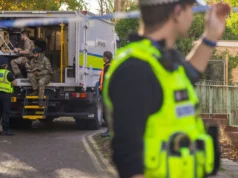The government has confirmed that Project ATILLA, the Army’s plan to convert retired Warrior infantry fighting vehicles into optionally crewed minefield-breaching platforms, has now advanced beyond its initial concept work and entered the early stages of commercial competition.
Responding to a written question from Conservative MP Ben Obese-Jecty, Defence Minister Luke Pollard said ATILLA “has progressed from considering conceptual elements such as evaluating project feasibility” and is now preparing to move into the Invitation to Tender stage. He did not provide a date for the formal end of the concept phase, but the answer makes clear that the programme has already passed that milestone.
The clarification follows earlier disclosures setting out the structure and ambition of ATILLA. As previously reported, the programme aims to turn surplus Warrior hulls into heavy, attritable uncrewed ground vehicles capable of breaching minefields for the Royal Engineers. A Prior Information Notice published in August revealed the MoD’s intention to procure up to six converted Warriors as a Minimum Deployable Capability, fitted with front-end breaching equipment and able to operate either with a crew or remotely.
From the outset, ATILLA has been designed as a spiral-development effort. Phase 1 will deliver the initial six vehicles for operational use and experimentation, while Phase 2 will focus on advancing autonomy and refining requirements for a future purpose-built heavy UGV fleet. Industry bidders must meet a stringent entry test, with only suppliers able to deliver six fully functioning optionally crewed breaching vehicles within the set time limits allowed to progress.
The logic behind the project is straightforward: Warrior’s retirement from frontline service leaves the Army with robust tracked hulls offering the mobility, protection and payload needed for high-risk engineering tasks. Converting them avoids the lengthy timelines and significant expense associated with designing a bespoke platform from scratch, and gives the Royal Engineers a survivable option for clearing minefields without placing crews directly in harm’s way.
According to the Ministry of Defence, by cutting through minefields, the device clears explosives and pushes them aside, opening a safe path for troops to move faster and more securely towards critical enemy positions or key objectives, outpacing current methods in speed and safety.
“The device, called WEEVIL, was developed collaboratively by the Defence Science and Technology Laboratory (Dstl) and Pearson Engineering Ltd – a British company based in the north-east – using the latest tech. WEEVIL can clear minefields quicker and safer than present capabilities, reducing risk to soldiers on the front line. Current mine-clearing methods include the TROJAN Armoured Vehicle, which requires a three-person crew to operate directly within hazardous areas.”
“The system prototype currently uses the Warrior Infantry Fighting Vehicle, fitted with a full-width mine plough, advanced remote-control system, and vehicle-mounted cameras. This allows it to be operated by a single person from several miles away from danger and is expected to be able to adapt to work with any suitable vehicle platform.
The ground-breaking trials are set to continue with the British Army, who will push the robotic system to its limits, providing vital insight to inform future mine-clearing capabilities. The prevalence of anti-tank and anti-personnel mines in modern warfare to slow troop movements has been highlighted by the conflict in Ukraine.”
The programme’s £12 million contract is expected to run from January 2026 to March 2028, with an option for a one-year extension.













MMMM! We might need all the Warriors we can lay our hands on following the latest shocking Ajax news!
I’ve been waiting for a Ajax post following the latest issues. I’m curious what is causing the problems and why it was accepted just a week or two ago.
Maurice, you surely know that Warrior is an IFV not a recce vehicle? Having said that WR has been used in an interim recce role to cover the capability gap between Scimitar being withdrawn and Ajax being fielded. Ministers do love their capability gaps!
I know that Graham, but I’m talking about the only options open to the Army. With Ajax out of service, there are only Warrior and Bulldog as tracked vehicles to fall back on.
Uncrewed is going to have to be the way since the latest addition to the fleet is breaking its crews. Again! Despite claims it was fixed. Never mind, someone twat is getting rich from the farce.
I was thinking it was labour that commissioned Ajax and conservatives failed to cancel and hence why it wasn’t canned as both parties were implicated in the bad decision, but it seems not, it was fully under the conservatives, so baffles the mind on why labour signed off on it
Got to worry that someone saw this coming with UK Gov declining to donate the “surplus” Warriors to Ukraine.
A few questions arise here,how many after all they would probably be a one shot capability? Does every Engineer Regt get them or just the CS regts? Obviously manpower in the Sqns and REME support will have to increase to run and maintain them!At least the AVREs and AVLBs and Terriers get used quite often these would probably just sit on the tank park more often than not,and as we know don’t use AFVs and the availability drops a good bit!
Hi mate. Indeed.
I’d guess on 22 and 26 RE would get them, as the CS Regs for 12 and 20 Bdes. And maybe the Reg which supports 7 Bde.
Trojan AVREs do other stuff than clear minefields! Yet I read they might be replaced by this, hope that isn’t true.
Bonkers if so. These should be in addition to the existing Titan Terrier Trojan AVLB AVRE fleet.
And just 6 initially? Whats that, a Troop per Regiment?
Why not bring back Shielder?
You know very well why we can’t bring back Shielder😂Lady Di would turn in her grave if we left the anti personnel ban treaty😉
Looking at the video apart from ploughing this in NO way can even remotely compete with Trojan in Armoured Engineer tasks!
If 32 was to get them that would be ironic as they had their armour took away despite the Regt being the original AER.
Daniele, Shielder was withdrawn from service becuase Scatterable Mines became illegal under the 1997 Ottawa Convention.
All this in the news about Ajax and not a peep from the UKDJ.
Nobody seems interested in reporting the bad news. We just see the spin about new this and new that sometime in the next decade or two, or three probably by the time it all goes wrong.
. No doubt when George gets the lowdown he will visit the Ajax saga!
Suspect that they might do quite a few, and given the recent rebuild at Ashchurch, it would make sense to have a “small” training fleet and keep the rest in long term CHE storage.
Whilst drones have been the game changer in the Ukraine war, their full potential comes being combined with area denial from mines, allowing smaller areas that require survallince and artillery when anything crosses that smaller area.
If mine fields can be cleared safely and quicky then the constant survallince from drones can be semi overcome, allowing for more options in attack.
Not sure this is the solution for it, as it would still be slow but it’s a step in the right direction.
When dealing with a minefield you always need to “step in the right direction.”